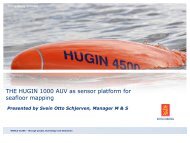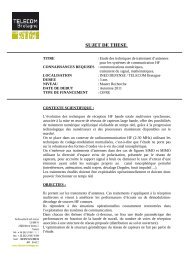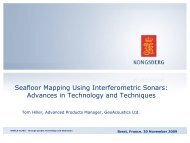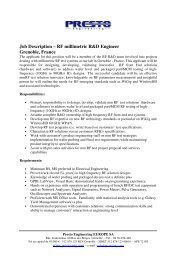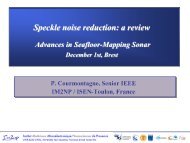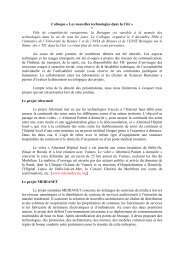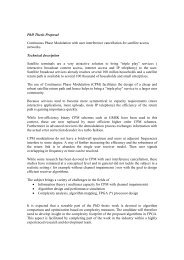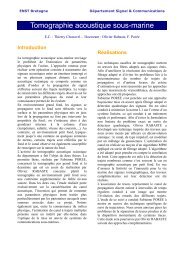Département Réseau, Sécurité et Multimédia Rapport d'Activités 2008
Département Réseau, Sécurité et Multimédia Rapport d'Activités 2008
Département Réseau, Sécurité et Multimédia Rapport d'Activités 2008
You also want an ePaper? Increase the reach of your titles
YUMPU automatically turns print PDFs into web optimized ePapers that Google loves.
Video on Demand in IP Multimedia SubsystemResearch Staff : Géraldine Texier Ph.D. Student : Gilles BertrandKeywords : Video on Demand, IMS, QoSApplications : Video on Demand, Fixe-mobile convergent n<strong>et</strong>worksPartners & Funding : Alcatel Lucent (leader), Devoteam SRIT, France Telecom R&D, InstitutTELECOM/TELECOM Br<strong>et</strong>agne, JCP-Consult, Thomson R&D, Thomson Broadcast & Multimedia.IntroductionThe emergence of new services proposed byfixed and mobile n<strong>et</strong>works implies theevolution of both the transport chain and thecommand chain. Normalization organisms forfix (TISPAN) and mobile (3GPP) n<strong>et</strong>works havedefined the IP Multimedia Subsystem (IMS)[4]as the reference architecture for nextgeneration services based on SIP (SessionInitiation Protocol) protocol.The goal of the VoD@IMS project is to addressthe issues of the conception, theimplementation and the experimentation ofnew usages generated by the combination ofthe on-demand content distribution domainand the convergence of fix and mobilen<strong>et</strong>works. This project is funded in theframework of the comp<strong>et</strong>itiveness cluster“Media and n<strong>et</strong>works” and constitutes anatural complement to Mobim@ges andDistrim@ges projects.VoD@IMS project’s main issues focus on:• the design and the implementation of aplatform prototype. This demonstrationplatform enables the validation of thearchitecture and the proposition made inthe project. The platform is designed inaccordance to the “IMS based”architecture currently understandardization.RealizationThe main contribution of TELECOM Br<strong>et</strong>agne isrelated to the n<strong>et</strong>work architecture analysisand more precisely on the quality of service(QoS) management in IMS and NGNarchitectures. The first realization is thecoordination and the contribution to the stateof the art on QoS by first presenting theexisting QoS mechanisms in the n<strong>et</strong>works andthen by a precise analysis of the QoS in IMSand in the NGN architecture, according toTISPAN. This first document has beencompl<strong>et</strong>ed by the study of the transport layerto guarantee QoS in TISPAN NGN architectureaccording to three axes:• the definition of new services based onnew technologies and new architectures(IMS, fix-mobile convergence, …) implyingon demand audio-video contents (personalvideo hosting by the ISP n<strong>et</strong>work, sharingand common preview of videos ondifferent sites, interactive services, …) andexploiting interactions b<strong>et</strong>ween thedifferent services;• the analysis of n<strong>et</strong>work architecturesneeded to service providing (IMSarchitecture, IPTV, …) in accordance withon going standardization efforts;• the validation of the proposed conceptsand the verification of the feasibility and ofthe acceptability of the comportment andthe performances of some functionalitiesof the system;• Within a domain. This lead to theproposition of an algorithm to allocate andshare the domain resources b<strong>et</strong>ween theflows according to the QoS. [1]• In the inter-domain context. TELECOMBr<strong>et</strong>agne proposed an architecture tooptimize inter-domain routing of the flowswith QoS and evaluated its performance.[2],[3]• The interactions b<strong>et</strong>ween the protocols.The proposed architecture has beenapplied to the scenarios defined in theproject.In the project, TELECOM Br<strong>et</strong>agne has focusedon the relationships b<strong>et</strong>ween the IMS core andthe transport layer and on the mechanisms toprovide in the transport layer to provide QoS inan efficient manner for multimedia sessions.Pracom’s Annual Report <strong>2008</strong> 15



